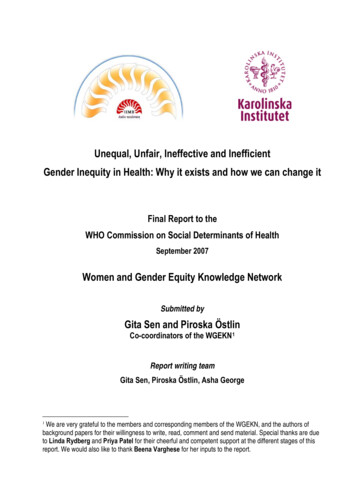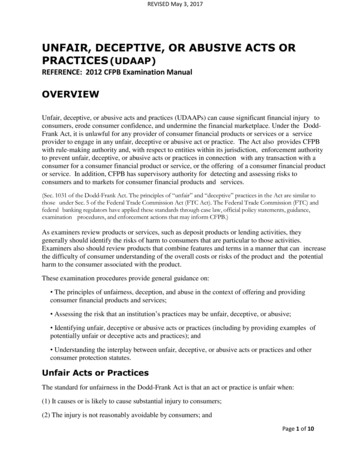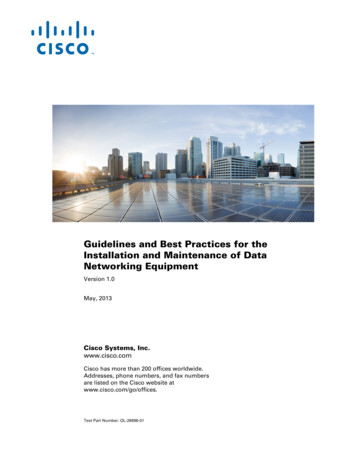
Transcription
Unequal, Unfair, Ineffective and InefficientGender Inequity in Health: Why it exists and how we can change itFinal Report to theWHO Commission on Social Determinants of HealthSeptember 2007Women and Gender Equity Knowledge NetworkSubmitted byGita Sen and Piroska ÖstlinCo-coordinators of the WGEKN 1Report writing teamGita Sen, Piroska Östlin, Asha GeorgeWe are very grateful to the members and corresponding members of the WGEKN, and the authors ofbackground papers for their willingness to write, read, comment and send material. Special thanks are dueto Linda Rydberg and Priya Patel for their cheerful and competent support at the different stages of thisreport. We would also like to thank Beena Varghese for her inputs to the report.1
MembersRebecca CookClaudia Garcia MorenoAdrienne GermainVeloshnee GovenderCaren GrownAfua HesseHelen KeleherYunguo LIUPiroska Östlin (Coordinator)Corresponding membersPat ArmstrongJill AstburyGary BarkerAnjana BhushanMabel BiancoMary Anne BurkeJames DwyerMargrit EichlerSahar El- SheneityAlessandra FantiniElsa GómezAna Cristina González VélezAnne HammarströmAmparo Hernández-BelloNduku KilonzoAuthors of background papersKarina BatthyánySonia CorreaLucinda FranklinAsha GeorgeVeloshnee GovenderAditi IyerHelen KeleherAarti Kelkar-KhambeteReviewers of background papersGary BarkerAnjana BhushanLesley DoyalJames DwyerSahar El-SheneityAlexandra FantiniAna Cristina González VélezAmparo Hernández BelloPeggy MaguireMary ManandharOther contributorsTanja HouwelingGabrielle RossRosalind PetcheskySilvina RamosSundari RavindranAlex Scott-SamuelGita Sen (Coordinator)Hilary StandingDebora TajerSally TheobaldHuda ZuraykJennifer KlotGunilla KrantzRally MacintyrePeggy MaguireMary ManandharNomafrench MbomboGeeta Rao GuptaSunanda RayMarta RondonHania SholkamyErna SurjadiWilfreda ThurstonJoanna VogelIsabel Yordi AguirreMelissa LaurieRanjani MurthyPiroska ÖstlinLoveday Penn-KekanaRosalind PetcheskySundari RavindranGita SenRachel SnowPiroska ÖstlinMartha RondonGabrielle RossGita SenHania SholkamyWilfreda ThurstonJoanna VogelHuda ZuraykMarion StevensGöran TomsonSusan Wattsii
AcknowledgementsWe express our gratitude for the collective patience and expertise generously offered by Knowledge NetworkMembers, Corresponding Members, Authors of background papers and case studies involved in this report, and theirReviewers. We are also indebted to Commissioners Hoda Rashad, Monique Begin, Mirai Chatterjee, Ndioro Ndiayeand Denny Vågerö for their guidance and support, and to Commissioner Rashad especially for hosting the Cairomeeting of the Knowledge Network. Our focal points, Gabrielle Ross from WHO and Tanja Houweling fromUniversity College London have been very supportive. Special thanks to Dorrit Alopaeus-Ståhl at the Ministry ofForeign Affairs in Sweden for her support and the external reviewers of the draft version of this report for theirvaluable comments. We thank also our colleagues in the Globalisation and Health Systems Knowledge Networks,who have been particularly helpful in sharing ideas and evidence.We thank also our institutions, the Indian Institute of Management Bangalore and the Karolinska Institutet in Swedenfor giving home to the organizational hubs of the Knowledge Network.DisclaimerThis work was made possible through funding provided by the World Health Organization (WHO), the SwedishNational Institute of Public Health (SNIPH) and the Open Society Institute (OSI) and undertaken as work for theWomen and Gender Equity Knowledge Network established as part of the WHO Commission on the SocialDeterminants of Health. The views presented in this work/publication/report are those of the authors and do notnecessarily represent the decisions, policy or views of WHO or Commissioners.iii
TABLE OF CONTENTSPOLICY BRIEFING.VIIIEXECUTIVE SUMMARY . XIII. INTRODUCTION. 1I.1 BASIC UNDERPINNINGS . 1I.2 BEYOND MOTHERHOOD AND APPLE PIE . 3II. THE EVIDENCE BASE OF THE REPORT . 5III. DIAGNOSIS: SO WHAT’S THE PROBLEM?. 6III.1 GENDER, WOMEN, EQUITY AND EQUALITY . 6III.2 INTERSECTING SOCIAL HIERARCHIES . 8III.3 SOCIAL STRATIFIERS AND STRUCTURAL PROCESSES – HOW DO THEY INTERACT? . 9III.4 CAUSAL PATHWAYS AND A FRAMEWORK . 10IV. GENDERED STRUCTURAL DETERMINANTS . 11IV.1 WHAT DO WE KNOW?. 11IV.1.1 Gender as a social stratifier. 12IV.1.2 Gendered structural processes . 14IV.1.3 Women’s movements and human rights . 21IV.2 PROMOTING HUMAN RIGHTS AND STRENGTHENING WOMEN’S HANDS. 22IV.2.1 Deepening the normative framework and realizing human rights . 23IV.2.2 Cushioning the ‘shock absorbers’ . 24IV.2.3 Expanding women’s capabilities – focus on education . 25V. NORMS, VALUES AND PRACTICES. 28V.1 WHAT DO WE KNOW?. 28V.1.1 How do norms work?. 28V.1.2 Gendered norms affecting health . 30V.2 CHALLENGING GENDER STEREOTYPES AND HOW THEY AFFECT HEALTH . 33V.2.1 Create formal agreements, codes and laws to change norms that violate women’s human rights, andimplement/enforce them . 34V.2.2 Adopting multi-level strategies to changes norms including support for women’s organisations . 36V.2.3 Working with boys and men for male transformation . 40VI. DIFFERENCES IN EXPOSURE AND VULNERABILITY. 42VI.1. WHAT DO WE KNOW?. 42VI.1.1. Mapping male-female differences in health . 42VI.1.2. Understanding male-female differences in health. 43VI.1.3. Exposure and vulnerability due to both sex and gender. 45VI.1.4. Exposure and vulnerability due primarily to gender . 48VI.2. REDUCING THE HEALTH RISKS OF BEING WOMEN AND MEN. 51VI.2.1 Meeting differential health needs . 51VI.2.2. Tackling social bias . 54VI.2.2.1 Tackling the structural dimensions of individual risk behaviour . 55VI.2.2.2. Empowering individuals and communities for positive change. 57VII. THE GENDERED POLITICS OF HEALTH CARE SYSTEMS. 60VII.1. WHAT DO WE KNOW?. 60VII.1.1. Women as consumers of health services . 61VII.1.2. Women as health providers . 64iv
VII.1.3. Accountability mechanisms for improved health services. 66VII.2 CHANGING HOW WE CARE AND CURE . 67VII.2.1 How to raise awareness and improve acknowledgment of women’s health problems . 69VII.2.2 How to improve women’s access to health care. 71VII.2.3 HOW TO STRENGTHEN ACCOUNTABILITY OF HEALTH SYSTEMS TO CITIZENS? . 75VIII. HEALTH RESEARCH . 79VIII.1 WHAT DO WE KNOW?. 79VIII.1.1 Gender imbalances in research content. 79VIII.1.2 Gender imbalances in the research process. 80VIII.2 CHANGING WHAT WE KNOW . 81VIII.2.1 Prerequisites for conducting gendered health research . 82VIII.2.2 What gets measured is what gets done – data and indicators . 84IX. REMOVING ORGANISATIONAL PLAQUE. 86IX.1 MAINSTREAMING AND CATALYSING GENDER EQUITY IN HEALTH. 86IX.1.1 Mainstreaming for gender equality and equity . 86IX.1.2 Gender mainstreaming in health . 90IX.1.3 Empowering women for better health . 92X. THE WAY FORWARD – GETTING THERE FROM HERE . 93REFERENCES . 99ANNEXES. 114ANNEX 1. LIST OF BACKGROUND PAPERS . 114ANNEX 2: CASE STUDIES . 1151. The impact on women of changes in personal status law in Tunisia .
2. Challenge gender stereotypes and adopt multilevel strategies to change the norms and practices that directly harm women’s health Create, implement and enforce formal international and regional agreements, codes and laws to change norms that violate women’s rights to health.











